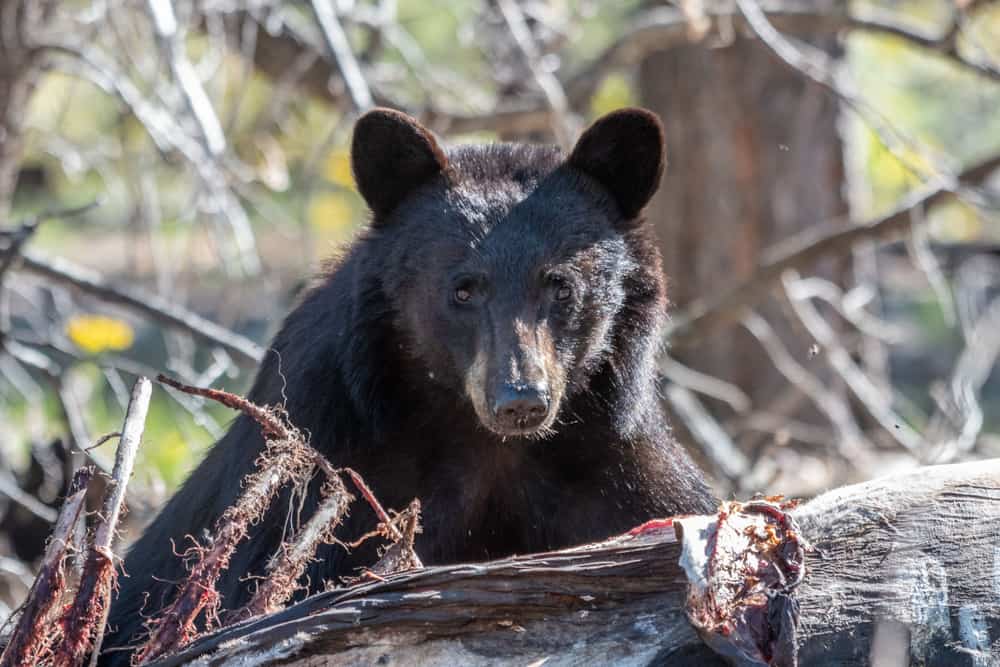The list of dangerous animals in New Mexico falls under 4 subheadings. These include Carnivores such as black bears and mountain lions, venomous arachnids such as venomous spiders and scorpions, venomous reptiles such as the gila monster and poisonous snakes, and dangerous insects such as killer bees and fire ants.
We’ll talk about each one of these in turn.
New Mexico’s most dangerous carnivores
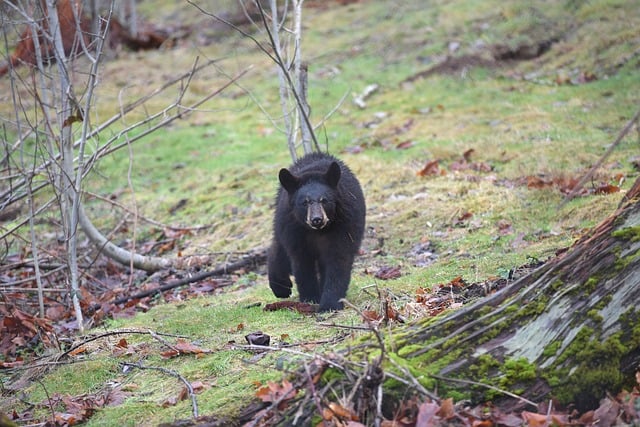
Black Bears (Ursus americanus)
New Mexico is home to roughly 8,000 black bears. See
Black bears live in most of the forested areas of New Mexico. It’s pretty common to find them around mountain campgrounds. Sometimes they even live near residential areas with nearby forested areas like Ruidoso, for instance.
What do black bears look like?
Adult black bears are anywhere from 50 to 85 inches long from the tip of the nose to the tip of the tail. Their average height is around 30 inches at the shoulder. The normal black bear’s weight range is from 140 to 400 pounds. However, males can be up to 70% larger than females. Standing on its hind legs, a large male black bear can be over seven feet tall. What’s more, some giant-sized individuals weigh over 800 pounds. The heaviest black bear ever recorded in New Mexico weighed 495 pounds.
Even though they are named black bears, their colors can vary from black, blue-grey, cinnamon, brown, blue-black, and on infrequent occasions, a black bear can even be white. Although most New Mexico bears are black, a small percentage of them are brown, cinnamon, or dark blond. Some black bears have a V-shaped white patch on their chest.
Other features that black bears have are long brown snouts, short tails, and small brown eyes, although their eyes are blue at birth.
Black bears lack the shoulder hump that brown bears or grizzly bears have. In areas that both species inhabit, the hump, or the lack thereof, is a distinguishing feature. Any wild bear in New Mexico will be a black bear, though.
How dangerous are black bears?
The knee-jerk response to that question is that black bears are timid, cautious animals; they’re more afraid of you than you are of them. All that is true most of the time. However, that’s only most of the time.
Here’s an example of a New Mexico black bear not being timid or cautious.
The following is from the Krebs Creek article titled Are Black Bears Dangerous to Humans?
“Black bears are not aggressive generally. They’re omnivores, which means their diet includes plant material but also meat. At times, black bears’ diets have been documented to consist of 96% plant material. This makes them one of the least predacious of all carnivores. However unaggressive they might be most of the time, black bears are still dangerous. In fact, at least one person is killed somewhere in North America each year by a black bear.
From 2001 through 2021, Black Bears killed twenty-eight people in North America. That’s a fact that flies in the face of the other points we know about these animals.
According to Doctor Stephan Herrero in his book “Bear Attacks, Their Causes And Avoidance,” from 1900 through 1980, 90% of the fatal attacks by black bears on humans in the United States and Canada were carried out by a predatory animal. In other words, 90% of the time, when black bears attack people, it’s because they view them as a food source.”
I’ll leave off there; if you want to read the rest of the article, you can click on the link.
The point is not to scare the reader. Black bear attacks are very rare. However, we’re dealing with unpredictable wild animals that have the ability to kill you with very little effort if that’s what they decide to do, and in rare circumstances, that’s exactly what they decide to do. Take that into consideration before you feed one.
“90% of the time, when black bears attack people, it’s because they view them as a food source.”Dr. Stephan Herrero “Bear Attacks, Their Causes and Avoidance,”
To see how to handle the situation if you encounter a bear in the wild, and how to set up your camp in bear country look at Camping in Bear Country
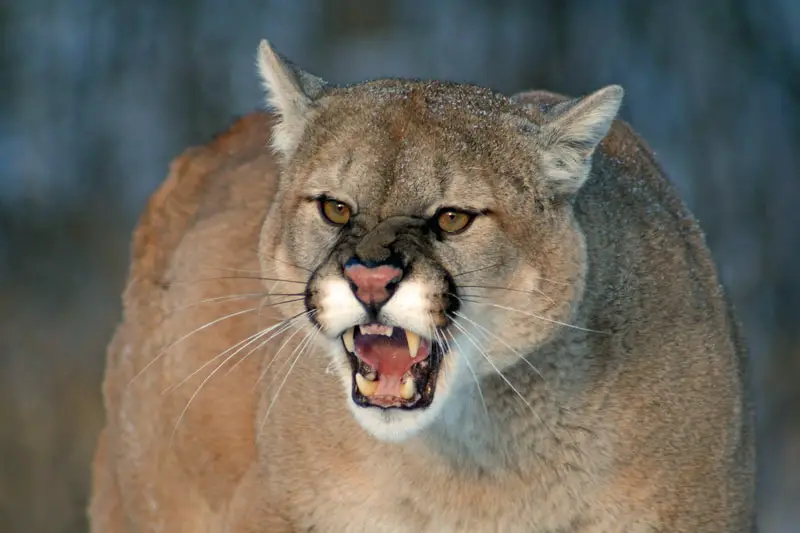
The Mountain Lion (Puma concolor)
Due to the fact that they live over a wide geographical area, mountain lions have a long list of regional names. In recent years, their scientific name was even changed from Felis concolor to Puma concolor. Some common names that mountain lions go by are cougar, panther painter, Andean Mountain lion, and puma.
Where are mountain lions typically found?
Mountain lions live on all three of the American continents. Their range begins in Canada’s Yukon territory and extends south through parts of North America, Central America, and South America to the southern tip of Argentina.
In Canada, the biggest populations of them are in British Columbia and Alberta. On the other hand, in the United States, they mainly live in the western united states and Florida in the southeast. In Florida, the cougar is called the Florida panther.
New Mexico is home to a little over 3500 mountain lions. See According to the U.S. Forest Service’s Large Predators of New Mexico Brochure; these big cats live in habitats that have some of the following characteristics.
- pinon pine
- juniper
- mountain mahogany
- ponderosa pine
- oak brush
- subalpine meadows
You’ll notice that all of these habitat types are good for deer. This is no coincidence. Deer are the mountain lion’s main source of prey. In fact, Mountain lions account for around 18 pounds of biomass and consume around 10 pounds of meat per day. To do this, an adult mountain lion has to kill a deer or a deer’s equivalent in meat around once a week. In New Mexico, they also prey on elk, desert bighorn sheep, pronghorns, feral horses, coyotes, raccoons, birds, rats, feral pigs, javelina, porcupines, skunks, snakes, small pets, domestic livestock, and literally any other native wildlife they can catch. See
Do mountain lions ever harm humans?
I’ve taken much of the following section from another one of my blog posts entitled “Are Mountain Lions Dangerous?” Found here.
Fatal mountain lion attacks on humans are extremely rare. In fact, there are only 20 records of fatal mountain lion attacks on humans in all of North America in the last 100 years. Don’t let that fact lull you into a complete sense of false security, though. There have been many more mountain lion attacks over the years that didn’t result in a fatality. Mountain lions are, in fact, dangerous.
A mountain lion is a formidably tough wild predatory animal. They can run 40 to 50 miles per hour for short bursts. Additionally, they can leap 18 feet vertically and 40 feet horizontally to catch their prey. These ninja-like predators typically stalk their prey from behind and then leap on an animal’s back. They then crush their cervical spine or larynx with their powerful jaws. They have a bite force of 750 pounds per square inch.
Some factors that cause mountain lions to attack humans
The majority of the time, mountain lions use their ghost-like skills to avoid human contact. On rare occasions, though, they attack humans. Below are a few of the reasons why.
- If the cougar has an injury or some sort of impairment that prevents it from killing its normal prey, it’ll be more likely to look at a person as potential prey.
- Male mountain lions engage in fights for territory. Some of their battles are to the death. A percentage of cougar attacks on humans are perpetrated by hungry semi-juvenile toms that have been kicked out of territories with a more abundant food supply.
- Scientific data suggests that mountain lions that were orphaned at a young age are more likely to attack humans. This is possibly because they missed the part of their training where their mothers taught them that humans are to be feared.
I don’t intend to scare the reader from being outdoors. Mountain lion attacks on humans are extremely rare. The drive you take to get into mountain lion country is statistically much more dangerous than being there is. However, you shouldn’t be so naive as to think that bad things never happen. Here is an occurrence that recently happened in Utah.
Click on the “Are Mountain Lions Dangerous?” link at the beginning of this section for more information on this subject.
New Mexico’s Most Dangerous Reptiles
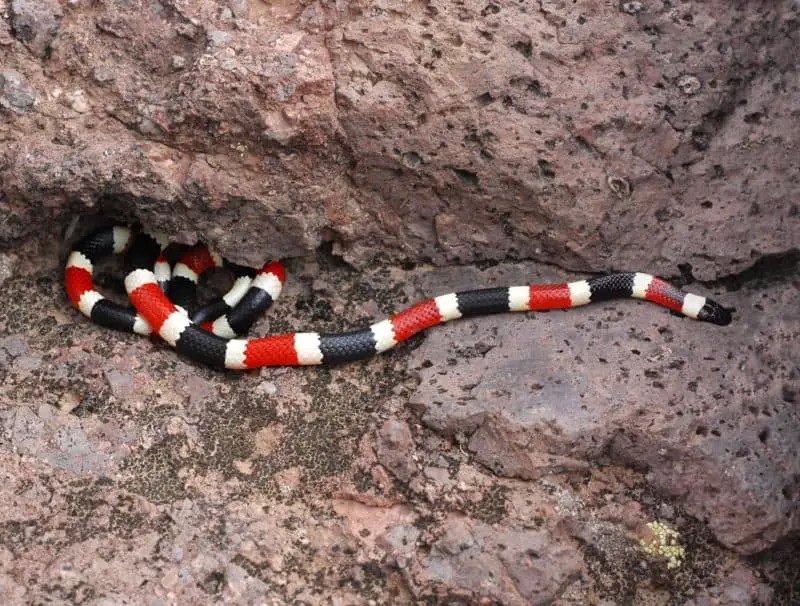
Coral Snakes (Micruroides euryxanthus)
New Mexico is home to the Western Coral Snake.
Coral snake venom is second only to the venom of the Black Mamba in potency. However, coral snakes are less dangerous than rattlesnakes. This is due to the fact that they have a less effective venom delivery system. For one thing, their mouths are small enough that while it’s not impossible for them to bite and envenomate a human, it’s much less likely for them to do so. Another thing is that their fangs are very small and don’t carry a very large dose of venom. When coral snakes bite their prey, a mouse, for example, they hold on to it and chew it to pump more venom into the animal.
There has only ever been one recorded case of a human fatality in the United States caused by a coral snake bite. See Don’t let that fact keep you from seeking immediate medical attention if you’re bitten by one, though. You don’t want to become case number two.
Western Coral Snake Identification
Western Coral Snakes are brightly colored, highly venomous snakes. They have black, light yellow, and red bands, with the yellow bands separating the red and black. A rhyme was created to help people differentiate between nonvenomous king snakes and coral snakes. “Red and yellow can kill a fellow; Red and black, a friend of Jack.” Western Coral Snake is a rather small, skinny snake (as skinny as a pencil) reaching between 13-21 inches in length. Their rounded heads and noses look similar to their tails. In fact, it can be hard to tell a Coral snake’s head from its tail.
Some of the best ways to identify a coral snake is that it has a blunt black head that is fully black even behind its eyes, and its color bands completely circle the body.
The best way to describe what they do when they are startled is that they fart. Some scientists say that they do this as a mating ritual, but others say it is aggressive- defensive behavior.
These snakes are mostly found in Catron and Hidalgo counties of southwest New Mexico. See
Rattlesnakes
New Mexico is home to 7 species of rattlesnake. According to the U.S. Food and Drug Administration website, there are around 8,000 people bitten by venomous snakes in the United States each year. Most of these are rattlesnake bites. Out of these roughly 8,000 snake bites, 10 to 15 0f them are fatal. See
The reason rattlesnake bites and venomous snake bites, in general, aren’t highly fatal percentage wise in the U.S. is because of the wide availability of medical care. If you are bitten by a rattlesnake, seek medical care as soon as you can. It’s your best chance for a positive outcome.
New Mexico is home to 7 rattlesnake species. They are the following.
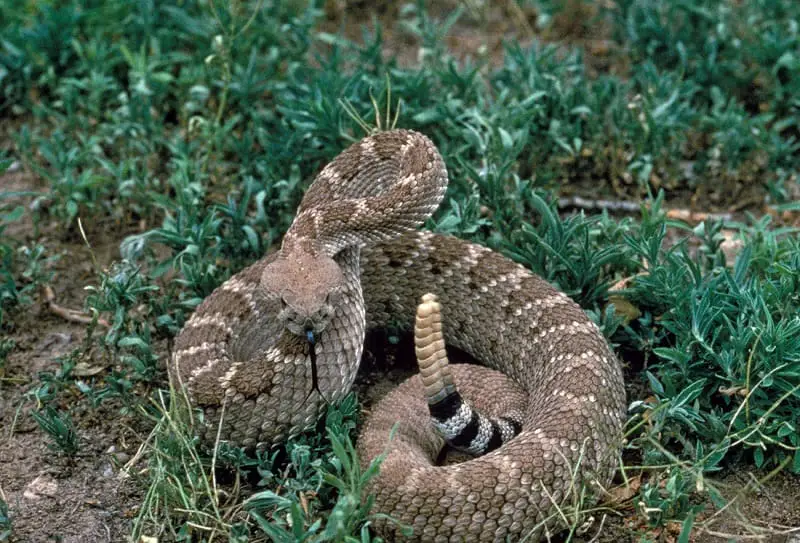
1: The Western Diamondback Rattlesnake
The Western Diamondback Rattlesnake is the largest of the southwestern desert rattlesnakes. They grow from 4 feet up to 7 feet long. They have dark diamond-shaped patterns along their back, which is why the name “Diamondback.” A dark line runs from the corner of the mouth to behind the eye. Their base color varies from straw-yellow, tan, salmon, gray, gray-brown, cream, or olive. The dorsal spots’ edges are usually darker, while the centers are only slightly darker than the base color. Their tail has two to eight black bands separated by pale gray bands.
The Western Diamondback Rattlesnakes are found all throughout New Mexico. In the rocky canyons, plains, deserts, and forests. It is the most commonly sighted rattlesnake throughout the state. It is the largest of all the rattlesnakes found in New Mexico.
Complications of a Western Diamondback Rattlesnake bite may include the following.
- Severe pain at the bite site
- Blood clotting defects resulting in severe internal bleeding
- Deep tissue and muscle damage
- Severe bacterial infection and gangrene
- Loss of function in the affected limb
- Paralysis
- Severe shock, seizures, and coma
- Multiple organ failure source.
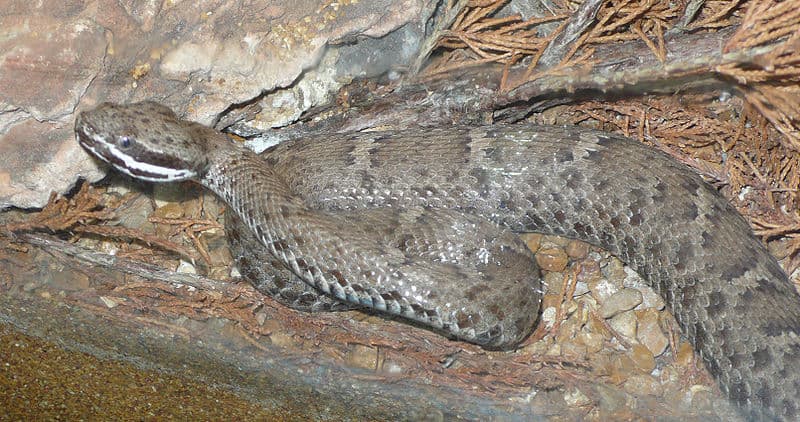
2: Animas Ridgenose Rattlesnake
The Animas Ridgenose Rattlesnake is found in the Animas and Peloncillo Mountains, within the southwestern boot-heel of New Mexico. It lives in woodlands, grassy hillsides, and canyon bottoms. It is listed by the U.S. Fish and Wildlife Service as being threatened in the state.
The Ridge-nosed Rattlesnake is rather small, measuring between 12 -24 inches. They generally have a brownish-gray base with brown blotches. They have a pale upper facial stripe on their upper jaw. The ridges along each side of its nose are unique to this rattlesnake and are why the name “Ridge-nosed.”
They have hemotoxic venom, which is not as life-threatening as other rattlesnakes because they discharge low venom yields. Even though pain and discomfort result from a rare bite, there have been no documented deaths caused by their bite.
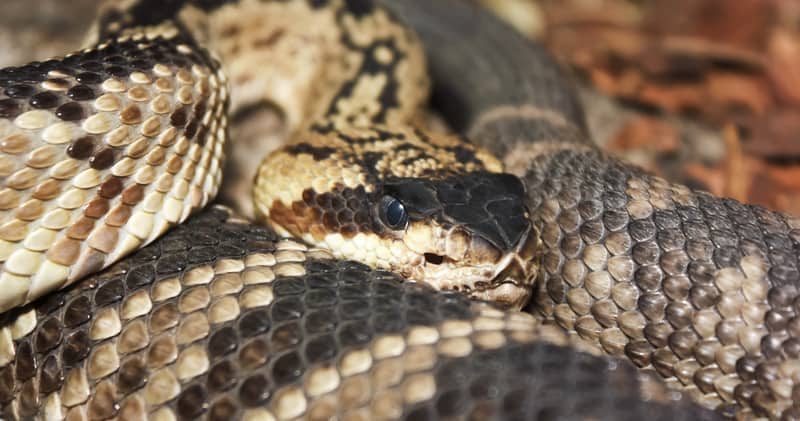
3: Mojave Rattlesnake
The Mojave Rattlesnakes are usually brown, olive-green, dark green, and even tan-looking in color and have a diamond-like pattern that ranges throughout their bodies. An adult Mojave Rattlesnake can grow anywhere from two to four feet in length; their tails have white and black bands on them.
The Mojave Rattlesnake is discovered in the state’s extreme southern part, in the desert or grassland habitat. These rattlesnakes’ preferences are usually high desert (500 – 5,000 ft. elevation) and lower mountain slopes. They like desert flats instead of an area that has high volumes of vegetation or rocky areas.
The Mojave Rattlesnake’s venom is neurotoxic-hemotoxic. “A bite from a Mojave Rattlesnake can cause a lot of local swelling, bruising, and even tissue damage, but what it’s notorious for is it can actually cause paralysis and even cause you to stop breathing.” Source
Complications of a Mojave Rattlesnake bite may include the following.
- Depleted heart function due to hyperkalemic cardiotoxicity
- Severe internal bleeding
- Deep tissue and muscle damage
- Bacterial infections and gangrene
- In rare cases, compartment syndrome may occur in the effected area.
- Loss of function in the effected limb
- Rhabdomyolysis, which, if not immediately treated, can lead to kidney failure
- Flaccid paralysis
- Severe shock
- Seizures
- Coma
- Multiple organ failure Source
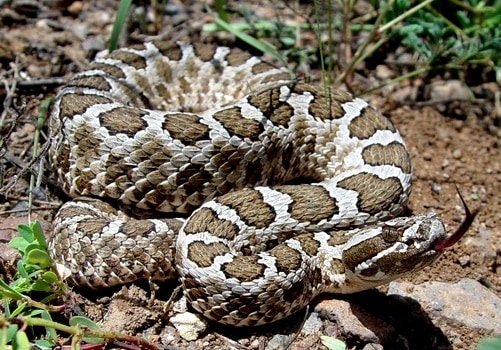
4- Desert Massasauga
The Desert Massasauga is scattered across southern, central, and eastern New Mexico in the desert grassland, often in sandy areas.
This rattlesnake is a small snake that reaches a length of 21 inches. These snakes have a pale gray body with dark brown blotches. It has a dark stripe that goes from the side of its head and across its eye. They are given the nickname “buzztale” for their high-pitched rattle sound, which is different from other rattlesnakes.
The venom of the Desert Massasauga Rattlesnake is cytotoxic venom that destroys tissue. The cytotoxic venom contains digestive enzymes that disrupt blood flow and prevent blood from clotting. A bite to a human is rare. Most bites occur after someone deliberately handles them or accidentally steps on one. In Ontario, Canada, there are two cases of people dying from a not properly treated bite because the specific antivenom is not easily acquired.
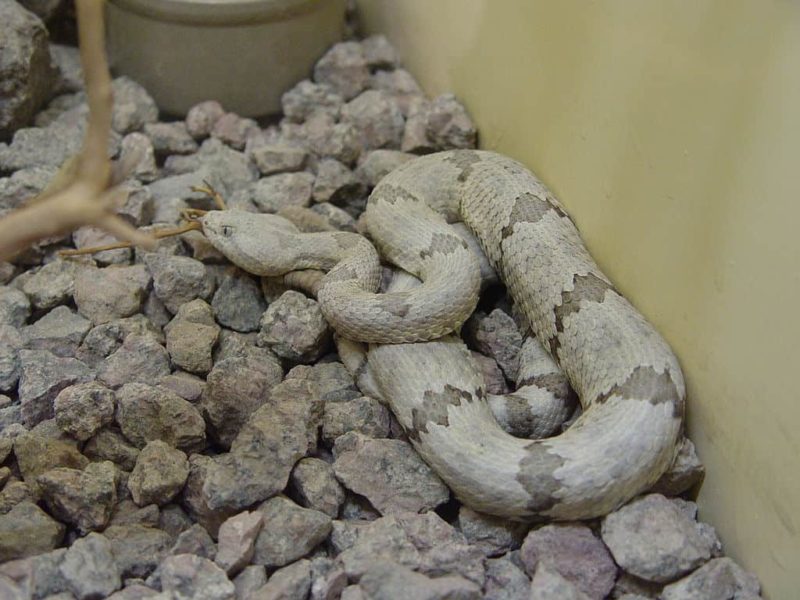
5: Mottled Rock Rattlesnake
The Mottled Rock Rattlesnake is a smaller snake that rarely exceeds 32 inches in length. Its color pattern varies with the color of the rock in its environment. The rock rattlesnakes that are found in limestone areas are a light gray color with darker gray bands. On the other hand, snakes found in higher altitudes are darker colored. Snakes found in the Davis Mountains region have a pink color, with dark gray speckles rather than banding. For the most part, their venom is a hemotoxin, but it has been known to have neurotoxic effects.
The Mottled Rock Rattlesnake is found in the isolated mountain ranges of southern New Mexico.
Complications from a Mottled Rock Rattlesnake bite may include the following:
- Depleted heart function due to hyperkalemic cardiotoxicity
- Severe internal bleeding
- Deep tissue and muscle damage
- Bacterial infections and gangrene
- In rare cases, compartment syndrome may occur in the effected area.
- Loss of function in the effected limb
- Rhabdomyolysis, which if not immediately treated, can lead to kidney failure
- Flaccid paralysis
- Severe shock
- Seizures
- Coma
- Multiple organ failure Source
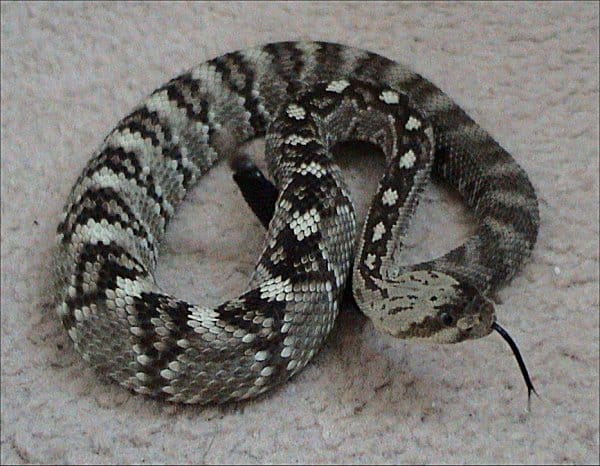
6: Northern Black-tailed Rattlesnake
The Northern Black-tailed Rattlesnake is found within southwestern and central New Mexico, in the rocky mountainous areas, and occasionally in the low desert.
This medium-sized rattlesnake measures 30 to 42 inches in length. The males tend to be smaller than the females. They range in color from yellow, olive green, or gray. Despite variation in body color, their most distinguishing feature is their entirely black tail scales. On their face, they have a black band across their eyes, which extends diagonally to the corners of their mouth, like a mask.
The venom of the Northern Blacktail Rattlesnake is hemotoxic. However, it is only two-thirds as toxic as the venom of the Western Diamondback Rattlesnake and, in general, is not fatal to humans. They have larger venom glands than most rattlesnakes in the area. Because its venom is less toxic, it needs to inject a large quantity into its prey to be effective.
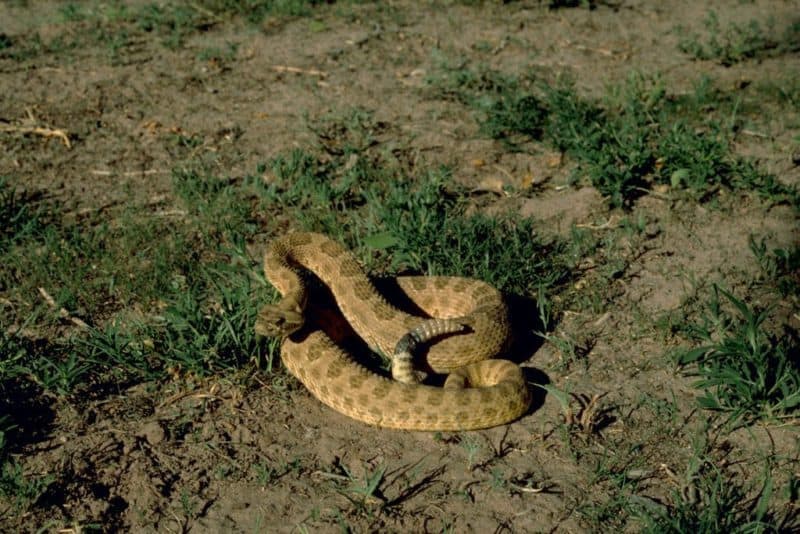
7: Prairie Rattlesnake
The Prairie Rattlesnake grows anywhere from 3ft to 5ft long. They are tan-colored with varying colors of brown blotches covering their bodies. They have a distinguishing triangle-shaped head with pit sensory organs on either side. A light stripe runs diagonally from the back of its eye to its jaw, and another strip runs diagonally from below its eye to the corner of its mouth. Prairie Rattlesnakes are mostly ground snakes, but they occasionally climb into shrubs, bushes, or trees. Their venom is both hemotoxic and neurotoxic.
The Prairie Rattlesnake is found throughout New Mexico, from the grassland desert to the pine-oak forests.
A Prairie Rattlesnake bite’s signs and symptoms include extreme pain, blistering, swelling, nausea, and vomiting. The venom can impair blood coagulation and break down the red blood cells, leading to tissue necrosis, shock, and rarely multiple organ damage. Source Also see
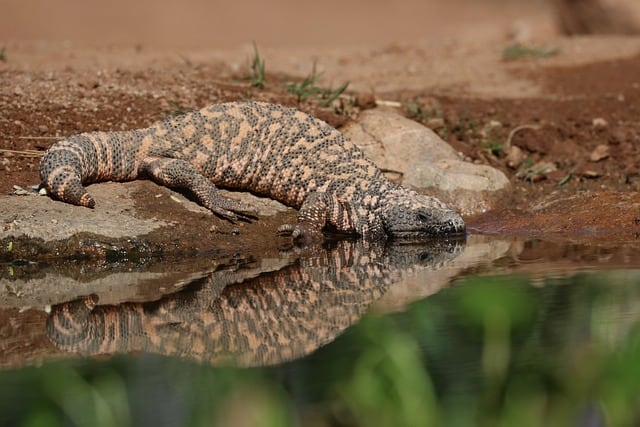
The Gila Monster (Heloderma suspectum)
The Gila Monster is one of only a handful of venomous lizards that exist in the world. The other example of a venomous lizard living on the North American continent is the Mexican Beaded Lizard.
Gila Monsters don’t have fangs to inject their venom as venomous snakes do. Instead, they have poison glands that are located in their lower jaw. They envenomate their target by chewing and letting the venom flow through their grooved teeth into the wound.
Gila Monster venom is about as toxic as that of the Western Diamondback Rattlesnake. However, the amount of venom they inject is relatively small, so bites are rarely life-threatening. See
Since they introduce their venom through chewing action, it may be difficult to get a Gila Monster to let go once it has a grip on you. You might try slapping it on the nose or prying its jaws open with a stick.
Once you’ve pried the Gila Monster loose from your flesh, you’ll need to seek medical attention.
According to the New Mexico Department of Game and Fish, if you want to see a Gila Monster, look in Hidalgo and Grant counties.
New Mexico’s Most Dangerous Arachnids
The state of New Mexico has two dangerous brown spiders and one black one. There’s also a scorpion in the state that’s sting can be deadly. We’ll talk about these next.
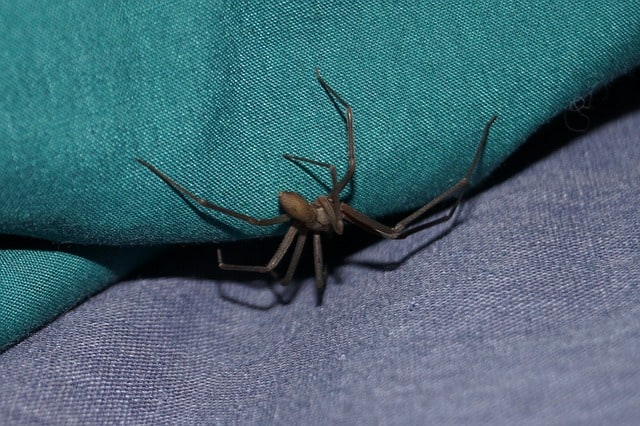
The Brown Recluse Spider (Loxosceles reclusa)
Brown Recluse Spiders are usually between 1/4 and 3/4 inches in diameter, with their legs extended. However, there are specimens that grow larger. While they’re typically light to medium brown, they range in color from whitish to dark brown or blackish gray. They generally have a contrastingly dark colored violin-shaped marking on the top of their cephalothorax, with the neck of the violin pointing to the rear of the spider. This is why they also have the nickname, fiddleback spider.
Brown Recluse Spiders have necrotic venom, which can destroy human skin and soft tissue. In extreme cases, bite victims develop a necrotizing ulcer at the sight of the bite that may take months to heal as dead tissue needs to slough away before it can do so. Brown Recluse Bites can also cause death in very rare instances. Most deaths occur in small children or those with a compromised immune system. See
Brown Recluse Spiders don’t have an aggressive nature. They rarely bite human beings. However, when bites do occur, it is usually a case of a person accidentally pressing one up against the skin inside of a glove or article of clothing.
In New Mexico, the Brown Recluse Spider mainly lives in the eastern portion of the state, from the Pecos River Valley east to Texas.
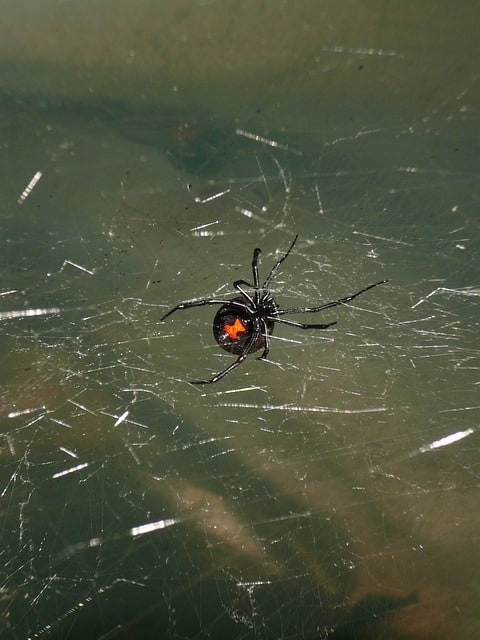
The Black Widow Spider (Latrodectus hesperus)
New Mexico also has the Western Black Widow Spider. The average body length of a mature Western Black Widow Spider is around 1/2 an inch. Their legs spread out 1 1/2 to 2 inches. Males are around 1/3 the size of females. The female’s body is shiny black with what is generally a red hourglass shape on the bottom of the abdomen. However, the hourglass can also be yellow or white in color.
Black widows have neurotoxic venom that affects the nervous system of bite victims. Their bite is dangerous, particularly to young children and the elderly. However, a black widow bite is rarely fatal.
There is an antivenom available for black widow bites. However, physicians only use it in rarely serious cases.
Black widow spiders are common throughout New Mexico. They prefer dark spaces in homes, such as crawl spaces and outbuildings or crevasses between rocks and animal burrows.
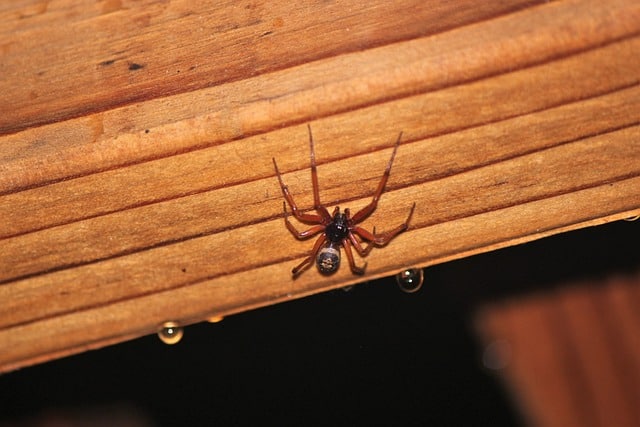
Brown Widow Spider (Lactrodectus geometricus)
Brown Widows, which are cousins to Black Widows, live throughout the state of New Mexico. Arachnologists believe that they originated in South America.
These spiders are roughly the same size as black widows but tan in color with black and white patterns on the sides of their abdomens They also have an orange-yellow colored hourglass shape on their bottom sides.
While Brown Widows have potent venom, they do not deliver as large a dose of it as their black cousins. However, if you have been bitten by a Brown Widow, you should still seek medical treatment.
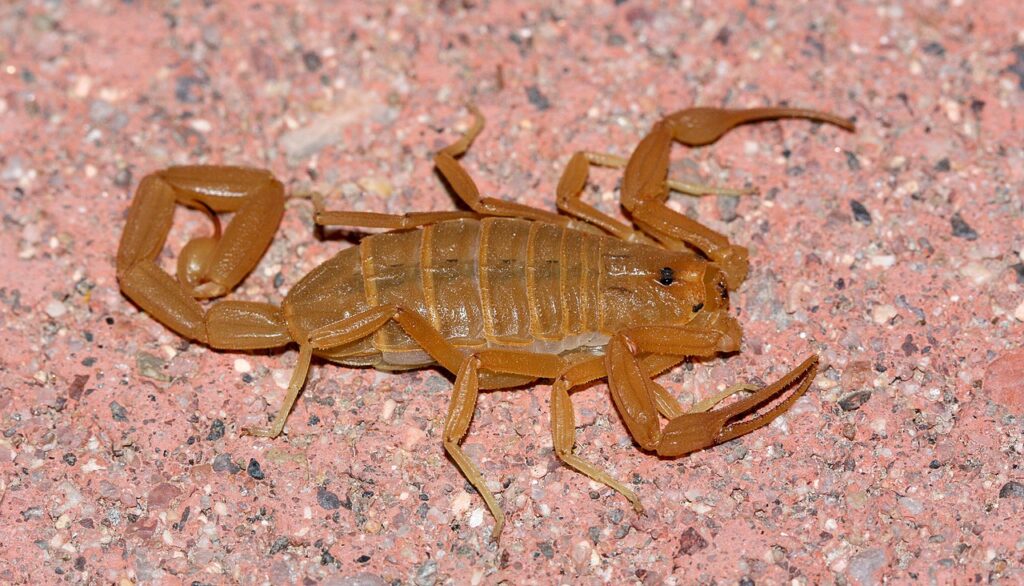
Arizona Bark Scorpion ( Centruroides sculptures)
There are around 25 different species of scorpion in New Mexico. However, the Arizona bark scorpion is the only dangerously venomous one. Most scorpion stings are no more dangerous than that of a wasp. However, the sting of an Arizona Bark Scorpion is much more serious.
The Arizona Bark Scorpion is quite small, with a maximum length of 2 1/2 inches. They are tan in color, with their back being slightly darker than the rest of their bodies. Another identifying characteristic is that bark scorpions, in general, are the only type of scorpion that hold their tails curled to the side when they’re at rest. Additionally, they are the only species of scorpion in New Mexico with the ability to climb rough surfaces. Consequently, they climb trees, walls, and other vertical objects as long as the surface has some texture to it. These scorpions tend to hide in the cracks of rocks, beneath tree bark, and in leaf litter.
Arizona Bark Scorpions closely resemble and are closely related to the Baja California Bark Scorpion Centruroides exilicauda. However, the sting of an Arizona Bark Scorpion is much more dangerous.
They are the most venomous species of scorpion in North America. The list of effects caused by an Arizona Bark Scorpion sting may last up to 72 hours. They will include all or some of the following
- significant pain
- numbness
- tingling, shortness of breath
- temporary loss of function and or convulsions in the affected limb
- vomiting
- In rare extreme cases, death
Since records have been kept, Arizona Bark Scorpion stings have killed 2 people in the state of Arizona. Arizona bark scorpion stings are particularly dangerous to young children and the elderly.
In New Mexico, Arizona Bark Scorpions live in the southwestern corner of the state. See
New Mexico’s Most Dangerous Insects
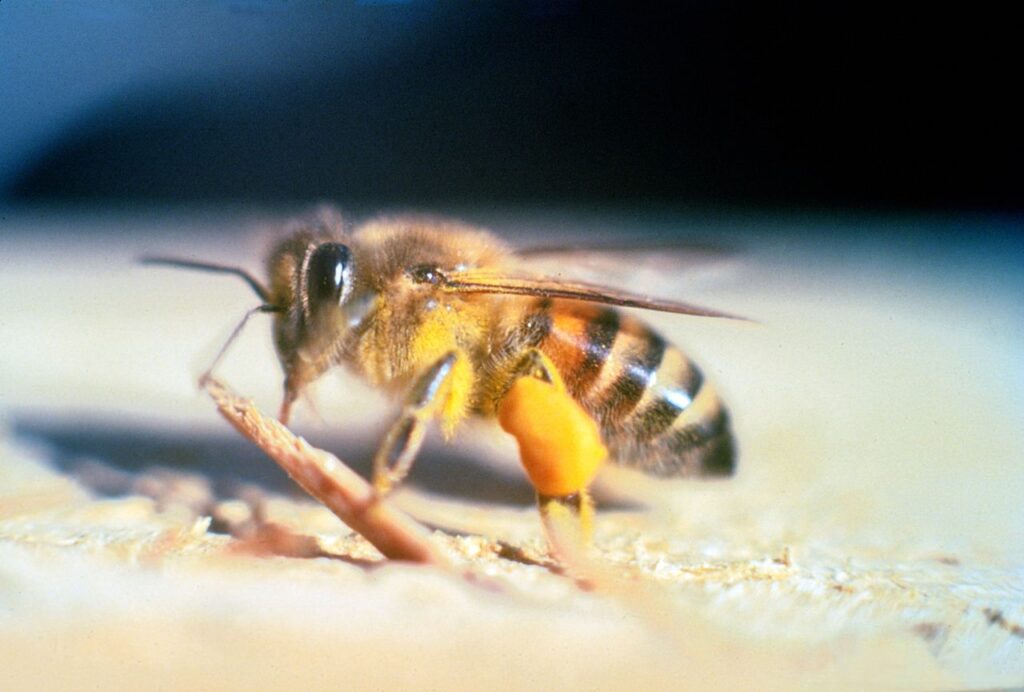
Jeffrey W. Lotz, F D of Agriculture and Consumer Services, Bugwood.org, CC BY 3.0,
Killer Bees (Apis mellifera scutellata)
Africanized honeybees escaped from a research facility in Brazil in 1957. They’ve been working their way north up through South, Central, and North America ever since. They found their way to New Mexico in the early 1990s.
Africanized honeybees or killer bees are similar to our European honeybees, except they are smaller and much more aggressive in protecting their hives. If you should accidentally disturb a hive of killer bees, you could potentially be stung 100s of times.
These uber-aggressive bees are responsible for over 1000 human deaths in the Americas since 1957.
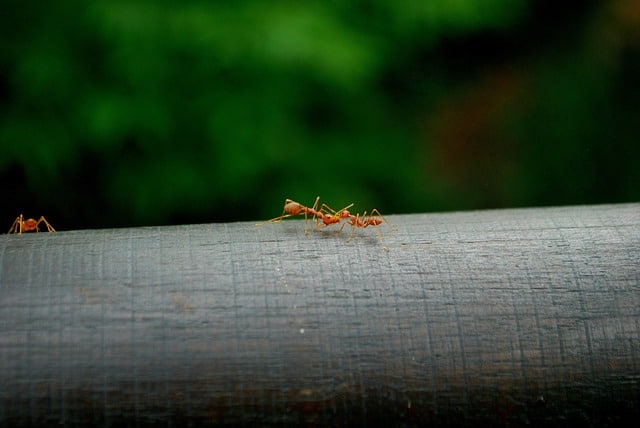
Fire Ants (Solenopsis invicta)
Fire Ants are aptly named because their sting produces a sensation that is not unlike your skin being on fire. If they get on you, they will sting you repeatedly.
The human body’s normal reaction to a Fire Ant bite is to form a localized itchy lump. On which a small pustule usually forms about 8 to 24 hours later
Some people develop a severe systemic allergic reaction to Fire Ant stings. This may include a wide range of symptoms such as welts or hives over the body, swelling of the tongue and lip, hoarseness, chest tightness or difficulty breathing, feeling faint, cramping abdominal pain, and “blacking out. See If you have any of these symptoms after being stung by Fire Ants, seek medical attention immediately.
Black imported Fire Ants, and red imported fire ants are both present in New Mexico. Both species aggressively attack perceived intruders to their colonies. The red variety is even more aggressive than the black variety.
In the United States, Fire Ants live in the southeastern states of Florida, Georgia, South Carolina, Louisiana, Mississippi, Alabama, and parts of North Carolina, Virginia, Tennessee, and Arkansas. They also live in Texas, Oklahoma, New Mexico, and California.
Recent Posts
The only venomous snakes in Washington State are Northern Pacific Rattlesnakes. The Northern Pacific Rattlesnake (Crotalus oreganus oreganus) is a sub-species of the Western Rattlesnake. Anyone...
Skunks are not classified as true hibernators. But they go into a state of torpor when the weather gets cold. Skunks are light sleep hibernators, along with opossums, bears, and raccoons. ...

